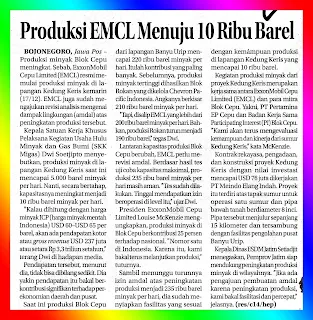The Ministry of Energy and Mineral Resources (ESDM) asked the Bojonegero Regional Government (Pemkab) to immediately complete the approval process for Environmental Impact Analysis (EIA/AMDAL) in the Cepu Block. The AMDAL revision is related to an increase in the production capacity of the Cepu Block in the range of 225-230 thousand barrels of oil per day (BOPD).
the Cepu Block
ESDM Minister Arifin Tasrif has heard about the AMDAL issuance process that is not going to be finalized soon. He immediately communicated with the Bojonegoro Regional Government.
Arifin Tasrif
"We hope that this EIA will be issued soon. For this reason, we will communicate with the local government, "Arifin said.
Arifin said that the Cepu Block has an important role in increasing national oil lifting production. Moreover, President Joko Widodo is tasked with increasing national oil and gas lifting production. Therefore the EIA approval process is a way to increase national oil lifting production.
"The point is this, how can we increase the lifting from the current one to go up a little more. To ride it does have to change the EIA again. So indeed for this EIA issue, we are asking the regions to be flexible, "he said.
Separately Chair of Commission VII of the House of Representatives (DPR) Sugeng Suparwoto asked the regional government to simplify the licensing process. Not even hinder that can have a broad impact.
"Appeal to the Regional Government, make it the Regional Government that prepares a red carpet for investors. How come we want to increase lifting but instead we make it difficult to permit, logic where ? "he said.
The Cepu Block has indeed become a mainstay of national oil lifting production. With its onstream Kedung Keris Field at the end of last year, it could increase the production of the Cepu Block by 10 thousand bopd.
The average production of the Cepu Block until September 2019 is around 216 thousand bopd. This means that the production of oil and gas blocks in Bojonegoro has exceeded the existing capacity of 220 thousand bopd.
Azi N. Alam
Meanwhile, Vice President of Public and Government Affairs of Exxon Mobil Indonesia, Azi N. Alam, said that the facilities in the Banyu Urip field could be used to produce oil up to 235 thousand bopd. This is the result of a series of tests carried out. But the increase in production is waiting for the AMDAL to be issued.
"From the test results it can be for 235 thousand, production facilities can, the reservoir is also safe, so it is only waiting for AMDAL," he said.
IN INDONESIA
ESDM Minta Pemkab Bojonegero Segera Terbitkan Amdal Blok Cepu
Kementerian Energi dan Sumber Daya Mineral (ESDM) meminta Pemerintah Daerah (Pemkab) Bojonegero segera menyelesaikan proses persetujuan Analisis Mengenai Dampak Lingkungan (AMDAL) di Blok Cepu. Revisi AMDAL itu terkait peningkatan kapasitas produksi Blok Cepu dikisaran 225-230 ribu barel minyak per hari (BOPD).
Menteri ESDM Arifin Tasrif sudah mendengar terkait proses penerbitan AMDAL yang tidak segera final. Pihaknya segera berkomunikasi dengan Pemda Bojonegoro.
“Kami harapkan Amdal ini segera dikeluarkan. Untuk itu kami akan melakukan komunikasi dengan Pemda,” kata Arifin.
Arifin menuturkan Blok Cepu memiliki peran penting dalam peningkatan produksi lifting minyak nasional. Apalagi Presiden Joko Widodo menugaskan untuk meningkatkan produksi lifting minyak dan gas nasional. Oleh sebab itu proses persetujuan Amdal menjadi cara untuk meningkatkan produksi lifting minyak nasional.
“Intinya kan ini bagaimana kita bisa meningkatkan lifting dari yang sekarang ada untuk naik sedikit lagi. Untuk naik itu memang harus merubah lagi Amdal. Jadi memang untuk isu Amdal ini, kita sedang minta daerah untuk bisa fleksibilitas,” ujarnya.
Secara terpisah Ketua Komisi VII Dewan Perwakilan Rakyat (DPR) Sugeng Suparwoto meminta pemda mempermudah proses perizinan. Bukan malah menghambat yang bisa memberi dampak luas.
“Himbauan untuk Pemda, jadikanlah bahwa Pemda itu yang menyiapkan karpet merah untuk investor. Kok kita mau meningkatkan lifting tetapi kita malah mempersulit ijin, logika dimana?” ujarnya.
Blok Cepu memang menjadi andalan produksi lifting minyak nasional. Dengan onstream-nya Lapangan Kedung Keris pada akhir tahun lalu dapat menambah produksi Blok Cepu sebesar 10 ribu bopd.
Rata-rata produksi Blok Cepu hingga September 2019 berkisar 216 ribu bopd. Artinya produksi blok migas di Bojonegoro tersebut sudah melebihi kapasitas yang ada sebesar 220 ribu bopd.
Sementara itu Vice President Public and Government Affairs Exxon Mobil Indonesia, Azi N. Alam, menuturkan fasilitas yang ada di lapangan Banyu Urip bisa untuk memproduksi minyak hingga 235 ribu bopd. Hal ini merupakan hasil dari serangkaian tes yang dilakukan. Namun peningkatan produksi itu menunggu AMDAL diterbitkan.
“Dari hasil tes bisa untuk 235 ribu, fasilitas produksi bisa, reservoirnya juga aman, jadi memang hanya menunggu AMDAL,” ujarnya.
Investor Daily, Page-9, Saturday, Jan 18, 2020

































